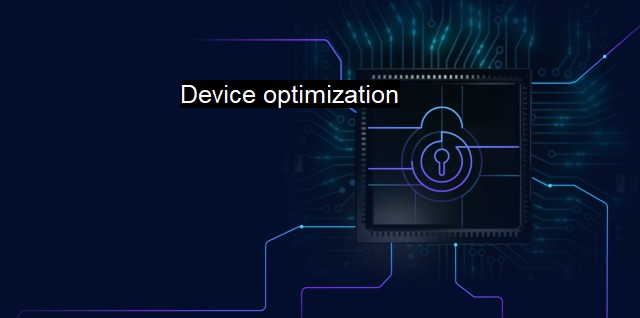What is Device optimization?
Device Optimization: Strategies for Enhancing Functionality and Cybersecurity against Potential Attacks
Device optimization is a pertinent concept within the sphere of cybersecurity and antivirus software. It spans across aspects such as efficiency, performance, functionality, and the security of devices, including desktop computers, laptops, smartphones, and tablets. To fully comprehend and appreciate device optimization in the context of cybersecurity and antivirus provisions, we have to dissect and look closely at what it involves, its implications, and the need.Cybersecurity can be defined as a multitude of protective mechanisms put in place to defend against internet-borne attacks. These mechanisms can shield computers, servers, mobile devices, electronic systems, networks, and data from digital threats. On the other hand, antivirus software is a program or a set of programs explicitly designed to detect, prevent, and remove malware, such as viruses, worms, trojans, ransomware, spyware, and other mischievous codes.
Device optimization in terms of cybersecurity and antivirus methods encompasses several actions, strategies, and protocols. Some most common actions include regular and efficient antivirus scans, timely software updates, robust data encryption, restrictions to unrecognized or unauthenticated entities, and maintaining a secure network connection, among others.
Performing regular and thorough antivirus scans can help to maintain optimal device performance. Scans help to identify and nullify potential threats before they inflict harm, degrade performance, or compromise data. By doing so, it prevents slowdowns and keeps the device working at optimum efficiency.
Timely software updates are another crucial factor in establishing and preserving device optimization. Whereas it isn't uncommon to observe a recurrent cycle of software updates, it is important to remember this isn't a scheme to irk users; all updates play essential roles in covering security vulnerabilities that cybercriminals might use to their advantage. They plug security loopholes, fix software program bugs, and replicate new features that help boost the device's performance.
Employing data encryption can enhance the security layers and work towards device optimization. By converting data into codes, encryption enables only authenticated entities to access and read encrypted files. This deters any potential data sniffers and provides reliable data protection.
Antivirus programs employ the concept of heuristics and continually rectify the definitions with each update to recognize malware and destructive codes. This way, they restrain access to unrecognized or unauthenticated programs, downloads, installations, and files, preventing system compromises and increasing device performance.
Lastly, using secure network connections contributes plagiarism strides to device optimization. Cyber attackers often leverage unstable or unencrypted networks to drive their operations. Employing firewall protection, using Virtual Private Network (VPN), enabling network encryption protocols, and patching wireless network software work towards the device's optimal productivity by keeping it safe from cyber threats.
Device optimization via cybersecurity and antivirus practices is a comprehensive approach to ensure smooth, efficient, glitch-free, and malware intrusions-free functioning of all devices at all times. Therefore, the device optimization doesn't merely refer to achieving high-performance speed, but it also stands for maintaining a level of security that deters unauthorized access to data and safeguards against potential cyber attacks.

Device optimization FAQs
What does device optimization mean?
Device optimization means improving and enhancing the performance of computer devices such as laptops and smartphones, to ensure that they are secure, efficient and reliable.Why is device optimization important in cybersecurity?
Device optimization is important in cybersecurity because it helps to ensure that the devices are protected against vulnerabilities and malware. Optimized devices are less likely to be compromised because they have fewer security gaps and are better able to defend against attacks.What steps can I take to optimize my device for cybersecurity?
To optimize your device for cybersecurity, you should keep your antivirus software updated, remove any unnecessary programs or applications, regularly back up your data, enable two-factor authentication, and use strong passwords.How can I know if my device is optimized for cybersecurity?
To check if your device is optimized for cybersecurity, you can run an antivirus scan to check for malware, run a disk cleanup to remove unnecessary files, make sure your operating system is up to date, and ensure that your firewall is enabled. These measures can help ensure that your device is secure and performing at its best.| | A | | | B | | | C | | | D | | | E | | | F | | | G | | | H | | | I | | | J | | | K | | | L | | | M | |
| | N | | | O | | | P | | | Q | | | R | | | S | | | T | | | U | | | V | | | W | | | X | | | Y | | | Z | |
| | 1 | | | 2 | | | 3 | | | 4 | | | 7 | | | 8 | | |||||||